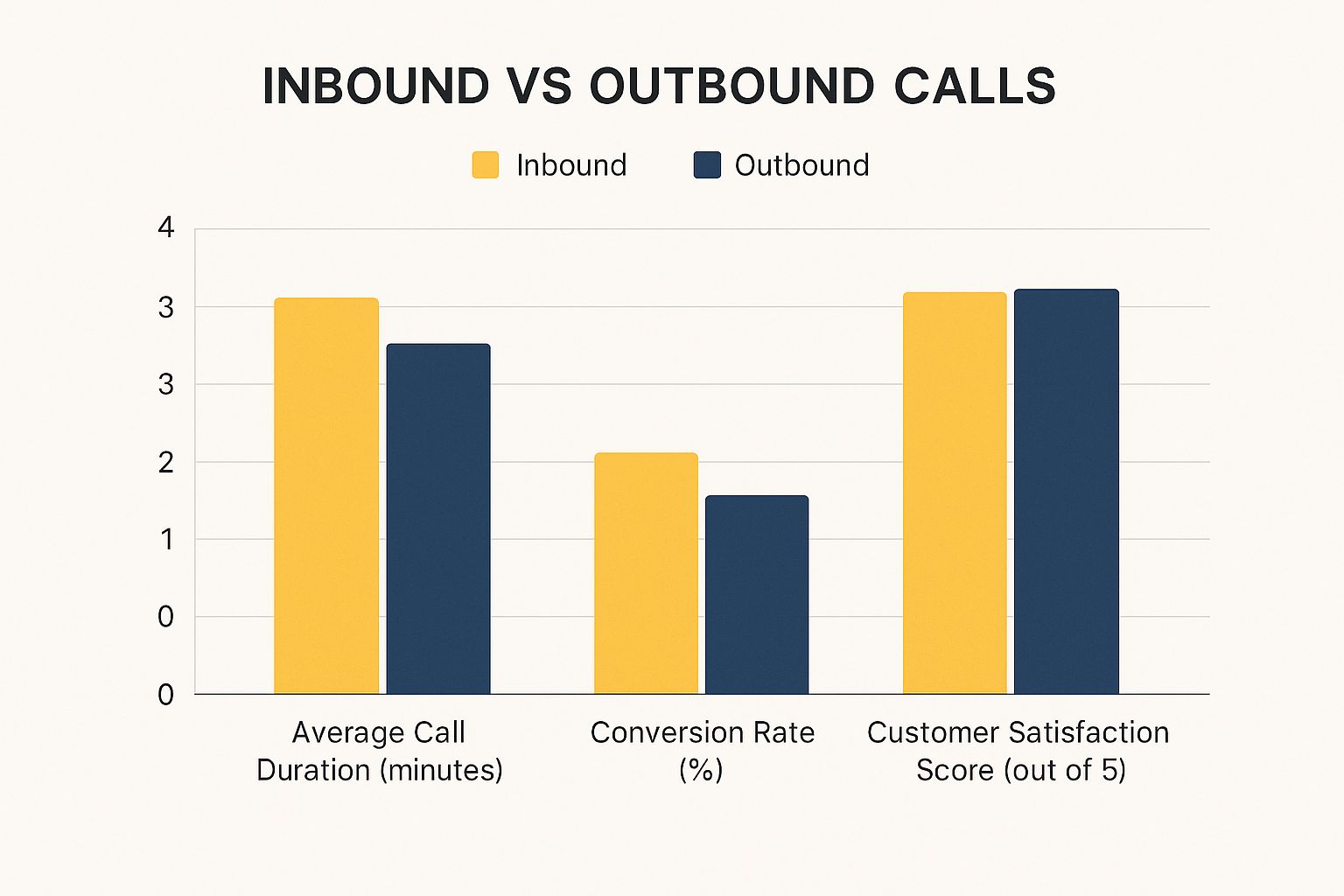It all boils down to one simple question: who's picking up the phone first?
When a customer calls you for help or information, that’s an inbound call. When you call a potential or existing customer, that's an outbound call. This simple difference—reactive versus proactive—is the foundation of any solid communication strategy, shaping everything from your team's goals to their daily conversations.
Getting the Basics Right
At its core, the whole inbound vs. outbound debate is about who initiates the chat. That first move sets the tone for the entire interaction. It determines the call's purpose, the customer's frame of mind, and the specific skills your agents need to nail the conversation. Get this right, and you're well on your way to a communication plan that actually works. If you want to dive a bit deeper into this, you can explore the real inbound call meaning and see how this reactive approach builds lasting customer loyalty.
Here in Australia, the old-school phone call is still king in contact centres. Inbound calls from live agents make up a massive 66% of all customer contacts. But what's interesting is how outbound calls are changing. It's not all about cold-calling anymore. These days, a huge 59% of all outbound calls are actually service-related—think callbacks about an ongoing issue or a heads-up about an appointment.
This shift shows us that both call types are more vital than ever, but their roles are definitely getting more complex.
Inbound vs Outbound Calls At a Glance
To make things crystal clear, let's break down the main differences between inbound and outbound calls. The table below gives you a quick snapshot of how they stack up against each other.
| Attribute | Inbound Calls | Outbound Calls |
|---|---|---|
| Initiator | Customer or Prospect | Business or Agent |
| Primary Goal | Resolve issues, provide support, answer questions | Generate leads, make sales, conduct surveys |
| Nature | Reactive | Proactive |
| Customer Mindset | Has a specific need or problem | May be unaware of the need or product |
| Agent Focus | Problem-solving, empathy, efficiency | Persuasion, resilience, goal-orientation |
This table lays out the fundamentals, but as you can see, the customer's mindset and your agent's focus are worlds apart. Nailing your call strategy means understanding these nuances and equipping your team for both scenarios.
How Inbound Calls Drive Customer Loyalty and Retention

While outbound calls are all about reaching out, inbound calls are where your customer relationships are really put to the test. Every time a customer picks up the phone to call you, it’s a moment of truth for your brand. This isn't just about troubleshooting; it's a massive opportunity to build rock-solid loyalty.
When you nail an inbound call, you're doing more than just solving a problem. You're reinforcing why that customer chose you in the first place. Think about it: research shows a positive customer service experience makes people more than three times as likely to recommend a company.
This direct interaction is your chance to fix things, show your value, and leave a positive impression that keeps customers coming back for years.
Turning Agents into Brand Advocates
The skills needed for inbound calls are totally different from what’s required for outbound. An outbound agent’s job is to persuade, but an inbound agent needs to reassure and resolve. Their real role isn't just to fix an issue but to listen, understand, and provide a clear, empathetic way forward.
Here’s what they really need:
- Deep Product Knowledge: Your agents have to be the experts. Answering complex questions without a second thought builds a customer's confidence in your business.
- Active Listening and Empathy: Really hearing a customer's frustration and showing you genuinely care is non-negotiable. It’s how you build trust.
- First-Call Resolution (FCR): Sorting an issue out on the first try is a huge driver of customer satisfaction. In fact, for every 1% improvement in FCR, you'll see a corresponding 1% improvement in customer satisfaction.
Get these skills right, and your support agents go from being simple problem-solvers to true brand advocates, strengthening the customer bond with every single call.
"An inbound call isn't an interruption to your day; it's the very purpose of it. Each call is a direct invitation to prove your brand's commitment to its customers, turning a moment of need into an opportunity for loyalty."
Measuring What Truly Matters
To know if your inbound strategy is working, you have to look beyond simple things like how long a call was. What really matters is how the customer feels after they hang up. In the competitive Australian market, tracking the right KPIs is vital.
You need to focus on these critical metrics:
- Customer Satisfaction (CSAT): This is a direct measure. A simple, "How satisfied were you with this interaction?" gives you immediate feedback on how your team is performing.
- Net Promoter Score (NPS): This one asks how likely a customer is to recommend your company, giving you a clear picture of overall brand loyalty.
By prioritising these KPIs, businesses can see exactly how their inbound calls contribute to customer lifetime value. Every positive inbound experience becomes another brick in the foundation of sustainable growth, proving that great service is one of the best retention strategies you can have.
Using Outbound Calls to Proactively Grow Your Business

While inbound calls are great for keeping current customers happy, outbound calls are the engine that drives proactive growth. Forget the old-school image of non-stop cold calling. Today's outbound strategy is a much smarter, more calculated approach for high-level lead generation, locking in qualified appointments, and getting direct feedback straight from the market.
This proactive approach means your business gets to start the conversation and control the narrative. You’re reaching potential customers who might not even know they need you yet. Imagine a B2B service provider using a targeted outbound campaign to introduce a new solution to a hand-picked list of businesses—it completely bypasses the slow burn of waiting for inbound leads to trickle in.
And it's not just for sales. Outbound is a fantastic tool for customer retention. Think about making proactive service calls to let clients know about an upcoming maintenance window. This simple act can prevent a massive wave of inbound support tickets down the line.
The Mindset and Skills for Outbound Success
Nailing outbound calls requires a completely different skill set than handling inbound. While inbound agents excel at empathy and problem-solving, outbound pros need serious mental fortitude and a strategic game plan to master the inbound vs outbound calls dynamic.
Here’s what sets them apart:
- Resilience and Goal-Orientation: Outbound agents hear "no" a lot. They have to be able to shake it off, stay motivated by their targets, and not get discouraged.
- Strategic Questioning: You don't have time to waste. The ability to ask sharp, insightful questions is key to quickly qualifying leads and digging into a prospect's pain points.
- Persuasive Communication: An agent needs to clearly explain the value you offer and handle objections with confidence to keep the conversation moving forward.
It's this unique mix of skills that turns a simple phone call into a real business opportunity.
An outbound call is a deliberate act of opportunity creation. It’s about starting a conversation that wouldn’t have happened otherwise, identifying a need, and positioning your business as the ideal solution before your competitors even get a chance.
Key Metrics for Measuring Proactive Outreach
To figure out if your outbound strategy is actually working, you need to track metrics that show proactive engagement and real results. Just counting the number of calls you make won't cut it; the focus has to be on the outcomes.
These are the critical outbound KPIs to watch:
- Contact Rate: This tells you the percentage of calls that actually result in a conversation with the right person. It's a great indicator of how good your calling list is.
- Conversion Rate: This is the big one. It tracks the percentage of conversations that lead to the result you want, whether that's a closed sale or a scheduled demo.
Keeping an eye on these numbers gives you a clear picture of the ROI from your outbound efforts. To give your team a serious edge and make sure you're hitting the right people, it's worth checking out the best AI lead generation software to fine-tune your prospecting. This helps you connect your strategy to tangible results, ensuring your proactive outreach is directly fuelling your business's growth.
Comparing Inbound and Outbound Call Centre Strategies
Getting your head around the basic differences between inbound vs. outbound calls is just the starting line. To really get your operations humming, you need to look at how each strategy plays out across your entire business, from the type of agents you hire to the tech you roll out. The right choice hinges entirely on what you’re trying to achieve.
At its core, an inbound strategy is reactive. It's all about being ready to tackle customer-initiated queries with speed and empathy. On the flip side, an outbound strategy is proactive; it demands that your agents make the first move to chase leads, lock in sales, or gather market info.
This fundamental split sends ripples through your whole call centre setup.
This image really highlights how the key performance metrics shake out between the two methods, stacking up things like call duration, conversion rates, and overall customer satisfaction.

As you can see, while inbound calls tend to score higher on customer happiness, a well-executed outbound campaign can absolutely smash it when it comes to conversion rates.
To help you weigh your options, let's break down the practical differences. The table below offers a side-by-side look at how inbound and outbound strategies stack up across key business areas.
Strategic Breakdown: Inbound vs. Outbound Calls
| Criteria | Inbound Call Strategy | Outbound Call Strategy |
|---|---|---|
| Primary Goal | Resolve issues, provide support, and build customer loyalty. | Generate leads, close sales, and conduct proactive outreach. |
| Agent Skillset | Empathy, patience, deep product knowledge, problem-solving. | Resilience, persuasion, goal-driven mindset, objection handling. |
| Key Technology | Automatic Call Distribution (ACD), Interactive Voice Response (IVR). | Predictive Diallers, CRM Integration for pipeline management. |
| Success Metrics | Average Handle Time, First Call Resolution, Customer Satisfaction (CSAT). | Conversion Rate, Contacts Per Hour, Lead Generation Volume. |
| Customer Interaction | Reactive. Responding to customer-initiated contact. | Proactive. Initiating contact with potential or existing customers. |
This breakdown makes it clear that your choice isn't just about call direction; it’s about aligning your entire operation—people, tech, and metrics—with your core business objectives. Whether you're building a support powerhouse or a sales machine, the right strategic foundation is everything.
Agent Skills and Training Focus
The kind of agent who shines in each role is worlds apart. An inbound agent is your classic problem-solver, armed with a deep well of patience, empathy, and product knowledge. Their mission is first-call resolution, and their training is all about active listening and calming down tricky situations.
Outbound agents, on the other hand, need to be tough as nails. They’re driven by goals, have persuasive charm, and aren't fazed by rejection. Their world revolves around navigating conversations towards a specific goal, like a sale or a booked appointment. Training for them is heavy on compelling scripts, handling objections, and knowing how to close.
The inbound agent is a problem-solver, building trust by resolving a customer's immediate need. The outbound agent is an opportunity-creator, building interest where none may have existed before.
Technology and Infrastructure Needs
The tech stack for each strategy is just as specialised. Inbound call centres are loaded with tools built to manage a flood of incoming calls without dropping the ball.
- Automatic Call Distribution (ACD): This is the brain of the operation, smartly sending callers to the right agent based on set rules to keep wait times down.
- Interactive Voice Response (IVR): IVR systems let customers help themselves or get to the right department, filtering calls before a human even gets involved.
Outbound teams use tech designed for high-volume, proactive outreach.
- Predictive Diallers: These power tools chew through call lists, automatically dialling numbers and only connecting agents when a real person picks up. Talk about maximising agent talk time.
- CRM Integration: A rock-solid CRM integration isn't a nice-to-have; it's essential for tracking every interaction, setting follow-ups, and keeping the sales pipeline flowing.
Key Performance Indicators and Success Metrics
Success is measured very differently in the inbound vs outbound calls debate, especially here in Australia. For inbound teams, it’s all about efficiency and satisfaction. Metrics like average handle time are huge—think around 97 seconds for sales and 130 seconds for tech support. The abandonment rate is another one that keeps managers up at night; long queues leading to dropped calls can wreck customer relationships.
For outbound, success is all about the outcome. You're looking at hard numbers like conversion rate (what percentage of calls lead to a sale?) and contacts per hour. These KPIs give you a direct, no-fluff reading of how effective your team is at generating business.
To make sure your team is prepped for anything, check out our guide on call handling best practices.
Which Call Strategy is Right for Your Business Goals?
Trying to decide between an inbound or outbound call strategy isn't about picking a winner. It's about matching your approach to what your business needs to do right now. Your goals should be the only thing guiding where you put your time, money, and team's focus.
The right choice comes down to your immediate priorities. Are you trying to keep the customers you've already won over, or is your main game to storm a new market as fast as possible? The answer will point you in the right direction.
Matching Your Strategy to the Situation
Let's break it down with some real-world business scenarios you'd find across Australia. Each situation calls for a different mix of inbound and outbound effort to get the job done.
Take a growing SaaS company that's noticed its customer churn rate is starting to creep up. Their number one goal is retention. In this case, they need to pour resources into their inbound support channels. This means getting agents trained up on deep product knowledge, aiming to solve issues on the first call, and making sure every customer interaction reminds them why they signed up in the first place. It's all about being excellent when customers reach out.
Now, picture a B2B firm launching a new service and needing to grab market share, fast. Waiting for the phone to ring just won't cut it. They need a targeted outbound strategy to get in front of decision-makers, book demos, and build that crucial first list of clients. Here, the focus is on proactive outreach to kickstart growth.
The Power of a Blended Model
While some goals clearly lean one way, the most robust, long-term strategy is almost always a smart combination of both. A blended model lets your inbound and outbound teams support each other, creating a communication machine where nothing falls through the cracks.
This synergy is what turns good service into great business. Imagine a customer calls your inbound line with a tricky technical problem. After your support agent sorts it out, they spot that the customer's account is up for renewal or could really benefit from an upgrade.
A blended approach turns a single interaction into a multi-layered opportunity. An inbound support call can become the perfect trigger for a proactive, value-adding outbound follow-up, boosting both satisfaction and revenue.
This is where the magic happens. The inbound agent can tee up a follow-up call for an outbound specialist. This isn't a cold call; it's a warm, relevant chat that feels like a natural next step after receiving awesome service.
Here’s how a blended model could play out for different goals:
-
Goal: Increase Customer Lifetime Value
An inbound agent fixes a billing mistake. A week later, an outbound agent follows up to offer a loyalty discount on their next purchase, making the customer feel valued. -
Goal: Gather Product Feedback
An outbound team calls a list of existing customers for a survey. That feedback is then used to get the inbound team ready for common questions about an upcoming feature release. -
Goal: Upsell and Cross-sell
A customer rings the inbound line to ask about a product's features. The agent gives them the info and flags their interest in the CRM, which then triggers an outbound sales call to talk about a complementary service.
By connecting your specific business goals to the right call centre setup, you make sure that every single call—whether it's coming in or going out—is pulling its weight and serving a clear, strategic purpose.
How Technology Brings Inbound and Outbound Calls Together
It wasn't that long ago that inbound and outbound call operations were completely separate worlds. Teams were stuck in their own silos, using different tools and chasing different goals. But modern tech has torn down those walls, creating a single, streamlined contact centre focused on one thing: a great customer journey, regardless of who made the call.
Unified communications platforms are the real game-changers here. They create one ecosystem where a "blended agent" model can really shine. This just means your staff can easily jump from handling an incoming support query to making a proactive outbound call, which is brilliant for balancing workloads and keeping everyone productive during quiet spells.
Creating a Single Source of Truth
The most important piece of the puzzle in uniting inbound and outbound calls is a solid Customer Relationship Management (CRM) system. When an agent can see a complete, 360-degree view of the customer's entire history, the direction of the call suddenly matters a lot less than the context behind it.
Think about it: an inbound agent sees that a prospect was just contacted by the sales team. That's fantastic background for their query. On the flip side, an outbound agent can see a customer's recent support tickets, letting them start the conversation with a bit of empathy and awareness. This shared intel makes every single interaction feel consistent and informed.
Technology transforms a contact centre from a bunch of separate departments into one intelligent hub. A unified platform gives agents the full customer story, making every conversation—whether it's inbound or outbound—far more meaningful and effective.
The Role of AI and Automation
Artificial intelligence takes this unified approach even further. AI-powered tools can analyse calls as they happen, giving agents handy prompts and sentiment analysis no matter who dialled the number. Once the call wraps up, automated summaries and action items get logged straight into the CRM, which saves a heap of time and keeps everything accurate.
To get a better handle on the tech that underpins unified call operations, you can explore comprehensive telephony solutions. Pulling these systems together is key. For any business wanting to get these capabilities up and running, the next logical step is to check out advanced call management software to build a truly cohesive, customer-focused operation.
Frequently Asked Questions

Is Inbound or Outbound Better for Small Businesses?
Honestly, there’s no single "better" strategy here. The right choice really comes down to what you need to achieve right now.
If your main goal is to keep your current customers happy and build loyalty, you'll want to double down on perfecting your inbound call handling. But if you need to drum up new business and get leads in the door fast, a well-planned outbound strategy is going to get you there quicker.
Most small businesses I've seen find that a mix of both is what really fuels sustainable growth in the long run.
How Do I Measure Success for Each Strategy?
You can't use the same yardstick for both, that's for sure. The success metrics for inbound and outbound calls are completely different animals.
For your inbound calls, you should be tracking KPIs like First Call Resolution (FCR) and Customer Satisfaction (CSAT) scores. These numbers tell you how efficient your team is and how happy your customers are with the service.
When it comes to outbound, it’s all about results. You need to focus on metrics like your Conversion Rate (how many calls lead to a sale or an appointment) and your Contact Rate to see if your outreach is actually hitting the mark.
Ready to master your business communications and never miss an important call again? OnSilent filters spam and organises your messages so you can focus on what truly matters. See how our AI Call Assistant can help you save time and capture every opportunity at https://onsilent.com.

